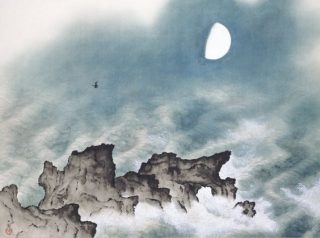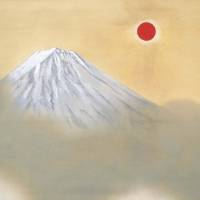
This painting by Yokoyama Taikan is a snapshot in summertime during the first-quarter moon. Sea and sky seem merge into each other and it is uncertain whether the waves are real or reflection of the moonlight. Only the India inked cliff gives the senses both of space and breaker sound. A black bird is lightly gliding upwind. If we could talk about a Japanese Romanticism, this figure is certainly a representative example.
The picture is from https://www.google.com/culturalinstitute/asset-viewer/summer-four-seasons-of-the-sea/zgGs0vys4l0y9w?hl=it&projectId=art-project

This painting could give the false impression that it looks like a sunrise, but it is a moonlight on the water. The Japanese prefer Autumn, among other seasons, because air is clearer and the moon shines fair at its best. Differently from the previous poster, the moon is here full and its nearly golden daylight gets stretched over and conveys its own calm grace to a large area of sea. A placid undertow provides even to this artwork a synesthetic suggestion, so that the three birds on the shore are not frightened. Once again, sky and sea mash together: the grey of the clouds falls into the grey-blue of the sea and what appears to be the whiteness of the meerschaum could instead be the multifaceted reflection of the moonlight on the water. Even the sand is enriched by the warm glow of the moon-enchanted seemingly liquid gold sky.
The picture is from https://www.google.com/culturalinstitute/asset-viewer/autumn-four-seasons-of-the-sea/6AHo1_DC5iPuNw?hl=it&projectId=art-project

The clarity of image in Taikan’s painting reproduced here is once again impressive. That is the symbol of immortality and Japanese identity, Mt. Fuji, that brings out in all its whiteness from the golden backdrop. The snowy ridge of the mountain is skillfully rendered by a dissemination of narrow chiaroscuros. The night mist starts to dissipate at the top as the sun comes up.
The picture is from https://www.google.com/culturalinstitute/asset-viewer/mt-fuji/gQGjCiwQOJy4bg?hl=it&projectId=art-project

At first sight, Yokoyama Taikan’s painting strikes precisely because it is simple to interpret. We are about looking at a specific photographic image of nature in the autumn; that image records some falling leaves, but not just that. The dense foliage that remains attached to the branches, springtime green to coppery in color, tries, any way it still can, to derive a residual vitality from the sap carrying trunk. The bird in the upper right seems to be about to migrate off, and in so doing shows wing opening with gravity while bends the body. The head leans forward and stands solitary and clearly out against the rarefied whiteness of the cloud background. Even a river landscape becomes apparent from a clifftop. The waves crashing against the cliffs are finely miniaturized along with the whitish foam. Its grey-green color joins the leave red-green color to give contrasting cold and warm dyes altogether. The river is represented by a blue colored uniform strip that vividly contrasts with the red foliage. There is no break in continuity, close to the slight waterfall jump, between the whitish foam and the luminescent cloud whiteness. The tree trunk itself seems to emerge from that continuum. The outlook is above the clifftop and a flattened backdrop replaces the deep-space rendering.
Yokoyama Taikan, a pseudonym for Sakai Hidemaro, was born in Mita on the 2nd of November, 1868 and died in Tokio on the 26th of February, 1958. His father, Sakai Sutehiko, came from a family of ancient samurai. The name “Yokoyama” was later given to him because he was adopted by his mother’s family.
The variegated life highlights regarding this painter could include, just to name a few, expulsion from the Bunten fine art opening sponsored by the Education Ministry in the year 1914, donating money from the sale of his paintings to the Japanese Army – for which he was interrogated as a war crime suspected by the occupying allied forces in Japan after the Second World War -, appointment by the Japanese Govern as player of the national artistic scene during a mission fulfilled in Italy in the year 1930 to illustrate the Japanese painting. Taikan’s patriotism, inherited from master Okakura Kakuzō, was expressed via a number of Mount Fuji views.He gave new impetus to the Japanese academy of fine arts who had attended and which had been closed after the death of Okakura, its founder, in 1913. He received several cultural awards and accolades.
The movement in which Taikan takes part is the so-called Nihonga current. During the Meiji Eve of the Japanese Empire (1868-1912), this current was the counterpart of Yōga one which was affected by the West originated Impressionism influence. On one hand, Nihonga current was a follow-up to the traditional Japanese painting, on the other it intended to propose for an innovative technique.
The picture is from https://www.google.com/culturalinstitute/asset-viewer/autumn-leaves/7wGv2-aJaMR26g?hl=it&projectId=art-project
Copyright © arteingiappone – All rights reserved